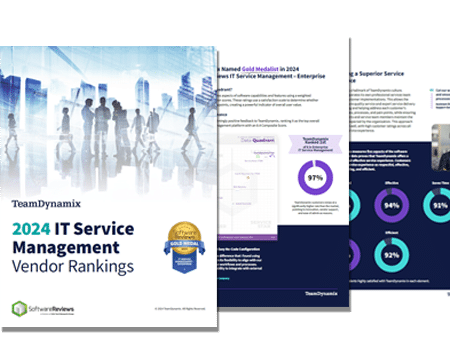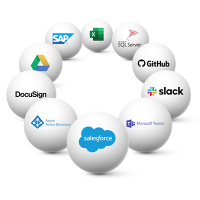
Unlocking ITSM Excellence: The Power of KPIs and Metrics
For nearly all organizations, IT Service Management (ITSM) stands as the backbone of operational efficiency, ensuring that IT services align not just with the needs

The Info-Tech ranking report offers a unique view of the market based entirely on in-depth customer interviews. Download the Info-Tech ITSM Quadrant and Customer Viewpoint report today.

We’ll show you some of our best situations and show you exactly how to execute them to get immediate results. The best part is, iPaaS tools often feature easy-to-use click and drag functionality, meaning you don’t need a dedicated employee building integrations and workflows.

System Integrators, Value Added Resellers, Technology Providers, and Buying Consortiums can benefit from a partnership with TeamDynamix.

The Info-Tech ranking report offers a unique view of the market based entirely on in-depth customer interviews. Download the Info-Tech ITSM Quadrant and Customer Viewpoint report to gain a better understanding of key vendor strengths and emerging market requirements.
How much time does your IT team spend resetting passwords, provisioning new machines, and onboarding or offboarding employees? If you are like any other organization in this world, your answer is probably “too much time.” As more and more technology is adopted, most companies now have 300-500 different applications they are managing, and supporting all of this is draining IT resources.
So, what is the answer? For many years, there was a movement to consolidate systems, to leverage large ERP platforms that could “do everything.” But what happened? Now we have large ERP platforms and hundreds of smaller SaaS-based solutions floating all over the enterprise.
As ticketing platforms took hold, IT teams saw a light at the end of the tunnel; let’s just organize the tickets, group the tickets, let’s push people toward self-service adoption. And all of this has indeed moved the needle… or at least nudged the needle. Why? Because more and more tech keeps pouring into the organization and with that, more and more resets, more and more touchpoints for onboarding and offboarding. The way forward may not be to simply push out more KB articles or to integrate chat.
According to a recent ITSM/ESM market study, the velocity at which change is required in the current environment is impossible to keep up with when organizations are waiting for an IT group that already has a huge backlog. The study found:
Many organizations are starting to adopt Integration Platform as a Service (iPaaS) in order to reduce the drain of IT resources and to chew through the never-ending backlog of integration and automation requests. The bonus here is that IT service management teams can take this platform and use it to streamline their own work – for instance, onboarding and offboarding employees. They can use it to facilitate a name change or any flow of data from one system to another.
Using a visual flow builder, you can easily do things like send a message out to Slack or Microsoft Teams, you can reset a password, or you can trigger a more complicated onboarding flow. Historically these types of automations would require programming and deep technical expertise. However, iPaaS platforms today are offering pre-built connectors to systems you use every day like Workday, the Active Directory, Office365, AWS and more. IT service management platforms with orchestration and workflow embedded can definitely make a difference.
When TeamDynamix first released iPaaS, Western University of Health Sciences was one of the first organizations to purchase and use it. “We definitely jumped at the opportunity to get iPaaS,” David Mitchell, Enterprise Application Administrator, said.
One of the key objectives for Mitchell and his team has been finding ways to save technicians time and make them more efficient – iPaaS lends itself nicely to that. “We are looking at what can save our technicians time, what are we already doing that may be more efficient with iPaaS and what systems do we need to integrate with iPaaS,” he said.
WesternU started by automating simple tasks with iPaaS, things like automatic VPN access for approved users, keeping assets up to date and reconciling data between Active Directory and Banner. “A lot of these tasks aren’t tasks that are necessarily hard for anyone to do manually, it’s more that they are repetitive and time-consuming.”
And for Mitchell and WesternU, that’s been one of the biggest draws for iPaaS.
One use case, in particular, has been beneficial for WesternU and that’s the workflow they built to address out-of-compliance Mac computers. Mitchell said they were having an issue with people taking home devices and then never using them again, so they built a workflow to monitor computer assets.
What the workflow does is add Macs that haven’t checked in for 365 days to a group in Jamf. That group gets monitored by a webhook in Jamf that then sends data to iPaaS.
When iPaaS receives the data, it pulls the details from Jamf and the details from TDX Assets. A ticket is then created automatically for the appropriate group with information about the Mac (who the owner is, its location, etc.). A post is also created in a special Microsoft Teams channel with all of the same information as the ticket, with links.
The benefit of leveraging an iPaaS platform outside of the ITSM platform is that you can create flows that do not originate or even touch the IT Service Management system. This flexibility allows companies to do things like move data between a CRM platform and a marketing automation tool. You can move data across multiple CRM systems, or you can combine data from an ERP with your HR platform. As IT Service Management teams are challenged to take on more and more tech support requirements, they need to be empowered to streamline their own operations and to service the company in ways not previously possible.
BYU-Idaho started exploring TeamDynamix iPaaS when they realized they wanted to automate various processes on their campus, specifically onboarding new employees and sending out financial aid notifications.
Using iPaaS, the team at BYU-Idaho created flows to take an employee through the entire onboarding process.
This is incredibly beneficial and saves the university a lot of time since they regularly hire student employees. These students need a lot of access to different tools and programs and giving access/taking it away is now a seamless, quick task.
“We’re doing a lot (with iPaaS) in HR with onboarding flows, and there are a lot of other groups around campus that want to use the onboarding flows to onboard an employee from the beginning, all the way to getting their equipment sent out and getting them into Active Directory,” Nepal Plummer, Director of Product and Service Management, said. “And we haven’t even opened up the floodgates yet.”
As for tracking student financial aid awards, the university used to have to send the award letters through Outlook with no way of tracking them. Now with iPaaS, there are individual tickets for each award letter so that counselors can see the information they need for each individual student.
They also created a flow that allows the IT team to recall and restore deleted data in tickets. Kevin Cook, Application System Engineer, explains the significance of this workflow, saying “We had 2500 tickets that didn’t have a value because that choice was accidentally deleted. So, we were able to use iPaaS to go out and grab a report with those tickets and update them to put that value back on the tickets.”
After other departments saw how helpful iPaaS has been, they are just waiting for their own chance to try it out.
Point-to-point connectivity is prone to error, and managing an unknown universe of APIs is ineffective and risky. It is time-consuming, prone to error and presents security risks. Creating workflows often requires coding, data is incorrect or not in the right format, and broken connections prevent proper automation.
OOTB Connectors to Enterprise Systems Can Help
Connectivity has historically relied upon APIs which pose security risks and can result in errors. This is why iPaaS platforms will offer a library of connectors to systems such as the Active Directory, Workday, SalesForce and Ellucian Banner. Simplify, centralize and secure your integration points.
Supercharge the Enterprise with Workflow
With iPaaS you can visualize flows as you build them. In order for an iPaaS solution to be easily adopted across the enterprise, the platform needs to be easy to use. With a visual flow builder, users can drag and drop connectors and trigger action without any coding or scripting.
iPaaS is a single integration platform with OOTB connectors to systems you use every day; easy to create API connectivity and a drag and drop flow builder to create true process automation. Visualize and create using a block and snap flow builder – no coding.
Bindi Bhullar, research director at Gartner says of iPaas, “In iPaaS we find the groundwork being laid for a digital future, as the products in this segment generally are lighter, more agile IT infrastructure suited for the rapidly evolving use cases around digital business.”
For organizations looking for an enterprise solution, TeamDynamix offers a full suite that brings IT Service Management and Enterprise Service Management (ITSM/ESM) together with Project Portfolio Management (PPM) for a single platform approach to transactional and collaborative work.
As a customer, you can opt to use just one aspect of the system or all of it together – or you can start by using just ITSM or PPM and then bring the other part online in a second phase.
The solution supports codeless expansion for groups such as Facilities, HR, Marketing and more.
Supercharge your organization with integration and workflow by leveraging the TeamDynamix iPaaS solution; connect to systems that you use every day and build workflows without any coding or scripting.
Without an integration platform, handling complex problems can be extremely difficult. Even if you manage to meet the costs of such a solution, making these systems work seamlessly will be extremely challenging.
An iPaaS solution resolves this problem by providing you with a unified and secure platform that pulls data from different sources easily. The platform provides integration capabilities to users who are not developers themselves, helping them manage and address new use cases like partner data exchange, application integration, cloud data warehousing and various application in an agile manner.
As a result, software services and businesses can manage multi-cloud hybrid environments and cloud integration efficiently. They no longer need to worry about the challenges of scaling services and data output, data storage and analysis of data, regardless of its location.
This article was originally posted in March 2021 and has been updated with new information.

For nearly all organizations, IT Service Management (ITSM) stands as the backbone of operational efficiency, ensuring that IT services align not just with the needs

The IT service desk plays a critical role in any organization, serving as the primary point of contact between customers/end users and the IT support

Did you know that a significant number of IT incidents occur when someone makes a change to one system that then affects other systems in
TeamDynamix’s award-winning SaaS cloud solution offers IT Service and Project Management together on one platform with enterprise integration and automation.
[email protected]
(877) 752-6196
Contact Us
